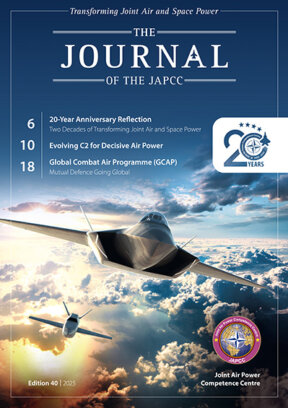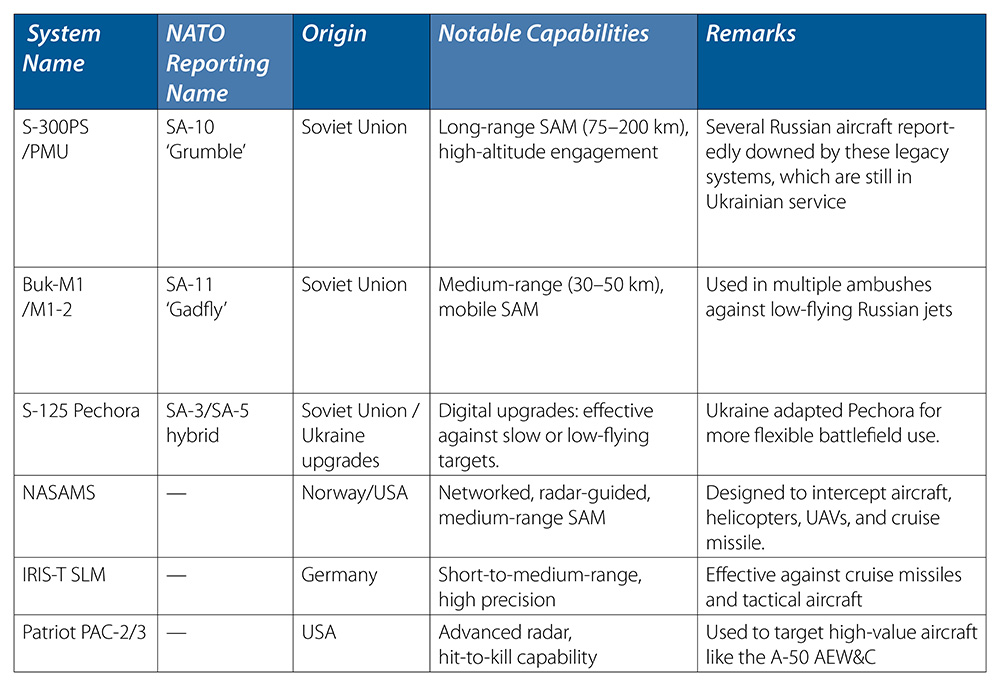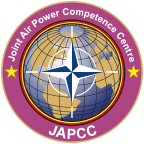Introduction
Author’s note: This is a non-classified article, and as such, some technical details and conclusions are omitted. NATO members are encouraged to reference JAPCC’s secure website for a more complete analysis.
Throughout the Russo-Ukrainian conflict, the Russian Aerospace Forces (VKS) have suffered significant combat aircraft losses, illuminating vulnerabilities in their airborne Electronic Warfare (EW) capabilities. Despite their long-held reputation for proficiency in the electromagnetic spectrum (EMS), the VKS has sustained extensive aircraft attrition. This includes high-value assets (HVAs) such as two Beriev A-50U ‘Mainstay’ airborne early warning and control (AEW&C) platforms, lost within a month in early 2024, and numerous Sukhoi Su-34 ‘Fullback’ strike fighters–reportedly nearly a quarter of the pre-war fleet. The destruction of the A-50s, with their low numbers and highly specialised crews, dealt a severe blow to Russia’s operational reach and situational awareness.1 While the precise financial impact is difficult to assess, the sheer number of aircraft lost is comparable to a decade of peacetime military aircraft production, underscoring the severity of these setbacks.2
These losses, inflicted by a combination of legacy Soviet-era air defence systems like the S-200 (SA-5 ‘Gammon’) and Buk-M1 (SA-11 ‘Gadfly’), alongside modern Western-supplied systems such as Patriot, National Advanced Surface-to-Air Missile Systems (NASAMS), and IRIS-T SLM, indicate systemic failures in Russian airborne EW.3 The VKS has demonstrably struggled to deploy effective EW countermeasures to protect its assets, even against known threats. The Su-34, one of Russia’s most advanced tactical aircraft equipped with sophisticated EW suites like the Khibiny, exemplifies this failure, with over thirty-five reportedly downed by Ukrainian air defences.4 This inability to effectively shield aircraft raises profound questions about the development, integration, and operational employment of Russian airborne EW. This paper will assess the doctrinal underpinnings of Russia’s reliance on EW, analyse the systemic and operational shortfalls observed in Ukraine, and consider the implications for Russian military adaptation and NATO’s strategic posture.
Russia’s Doctrinal Bet on EW: An Asymmetric Counter to Low Observable (LO) Technology
Russia’s emphasis on EW, or Radio-Electronic Combat (REB) in its doctrine, is not accidental but a deliberate strategic choice rooted in the post-Cold War technological landscape. Faced with the West’s, particularly the United States’, growing dominance in LO technology – exemplified by aircraft like the F-117A Nighthawk, B-2 Spirit, and later, the F-22 Raptor and F-35 Lightning II, Russia recognised its limitations in developing comparable LO platforms. A combination of an underdeveloped civilian electronics sector, lack of advanced precision manufacturing tools, industrial limitations, lagging composite material science, and persistent financial constraints hampered its LO technology ambitions, leading to the abandonment of early projects like the Mikoyan MiG 1.44 and Sukhoi Su-47 Berkut.5
Table: Key Ukrainian Air Defence Systems Used Against Russian Aircraft.25
Russian military thought, influenced by concepts of a ‘revolution in military affairs’ and the perceived efficacy of countermeasures, posited that LO technology was a solvable technical challenge.6 Consequently, Russia pursued an asymmetric strategy, prioritizing robust EW capabilities to degrade adversary sensor networks and protect its own, less LO, assets. This doctrine viewed EW as a protective adjunct and a central pillar of combat operations, designed to disrupt enemy Command, Control, Communications, Computers, Intelligence, Surveillance, and Reconnaissance (C4ISR) systems.7 The downing of an F-117A over Serbia in 1999 by a Serbian SA-3 Goa, reportedly aided by older Soviet radar techniques and intelligence, further solidified Russian confidence in their ability to counter LO technology through sophisticated air defence and EW.8
Key industrial defence players like the Concern Radio-Electronic Technologies (KRET) and design bureaus such as the Central Scientific-Research Institute for Radio Engineering (TsNIRTI) and the Kaluga Scientific-Research Institute for Radio Engineering (KNIRTI) spearheaded the development of advanced airborne EW systems. Notable examples include the KNIRTI L005S Sorbsiya pods for Su-27/30 aircraft and the more recent L-175 Khibiny family of systems, designed for platforms like the Su-30SM, Su-34, and Su-35. The Khibiny was touted as a sophisticated system, purportedly upgraded based on experiences in Syria, capable of jamming enemy radars and cueing anti-radiation missiles. This doctrinal reliance and industrial focus created an expectation of airborne EW dominance that has been severely tested in Ukraine.9
Operational Shortfalls and Systemic Failures in Russian Airborne EW
Despite possessing a diverse pre-war inventory of airborne EW assets, Russia’s performance in Ukraine has fallen short, failing to meet doctrinal expectations by protecting VKS assets. At the outset, Russian EW achieved some initial success in degrading Ukrainian Ground-Based Air Defence (GBAD) units. However, this advantage proved short-lived, as Ukrainian air defences demonstrated resilience and adaptability. In a manner of weeks, they had repositioned assets, reset radar systems, and restored air defence coordination, diminishing the impact of Russian EW.10 The three leading causes of failure include:
- Lack of Integrated SEAD/DEAD Operations: One fundamental failure has been the inability to effectively integrate airborne EW assets into cohesive Suppression or Destruction of Enemy Air Defences (SEAD/DEAD) campaigns. Russian airborne EW platforms, such as the Il-20M ‘Coot’ surveillance aircraft and Su-34s equipped with anti-radiation missiles (ARMs) like the Kh-31P and Kh-58, frequently operated without dynamic coordination with GBAD suppression efforts, artillery, or other air units. This lack of integration allowed Ukrainian SAMs, employing agile ‘pop-up’ tactics with independently operating Buk Transporter Erector Launchers and Radar (TELARs), to complicate Russian targeting and undermine the effectiveness of reactive ARM employment and EW.11
- Fragmented Command and Control (C2) and Data Fusion: Limited airborne C2 and data fusion capabilities have further hampered Russian EW effectiveness. Russian airborne EW and surveillance platforms like the Il-20M suffered from poor data dissemination. Communication methods introduced latency and reduced operational tempo, while Russia’s fragmented C2 structure hindered real-time EW coordination and prevented dynamic retaking of EW effects.12 Russia’s heavily centralised C2 significantly limited the flexibility of its airborne EW assets. In contrast, Ukraine’s more decentralised, NATO-influenced approach led to effective counter-jamming measures, frequent repositioning of assets, use of frequency-hopping spread spectrum (FHSS) techniques, and closer EW coordination with manoeuvre elements.13
- Technical and Integration Deficiencies:
-
- System Limitations: The Khibiny system, a digital radio-frequency memory (DRFM)-based jammer, primarily relies on generating powerful noise or deception jamming signals to overpower enemy radars. While potentially effective against older radar systems, this approach is less successful against modern agile radars employing sophisticated frequency-hopping techniques and advanced signal processing.14
- Platform Integration Issues: The physical characteristics of some EW pods, such as the SAP-14 ‘Stavropol’ escort jamming pod intended for strike fighters, reportedly introduce considerable aerodynamic drag, reducing aircraft range and endurance, thereby limiting their operational utility on specific missions.15
- Avionics Conflicts: A persistent weakness, stemming from an ageing defence industrial structure that often separates radar and EW design teams, has been the poor integration of EW systems with other onboard avionics. On some Russian aircraft, pilots reportedly must choose between activating their radar for targeting or ground mapping and employing their EW self-protection suite, creating critical vulnerabilities, particularly for aircraft like the Su-34 operating in contested airspace. While there are reports of Khibiny system modernizations aimed at minimizing pilot workload, their widespread implementation and effectiveness remain unclear.16
- Electromagnetic Interference: Poor coordination and deconfliction of EW activities, exacerbated by deficiencies in communications and radio discipline among Russian forces, led to instances of electromagnetic interference. Reports of self-inflicted degradation indicate that Russian jammers, intended to disrupt Ukrainian systems, likely interfered with their own communications and C2 networks. This reportedly led to a reduction of some EW operations early in the invasion, allowing Ukrainian air defences to regain the initiative.17
These operational and technical shortfalls reveal deeper systemic problems: rigid command structures unsuited to dynamic electromagnetic environments, persistent defence industry issues impacting quality and innovation in airborne systems, and inadequate training for complex, contested electromagnetic operations.
For example, the VKS’s traditionally hierarchical and centralised C2 system hindered the agility required for modern EMS operations. In a domain in which success or failure is determined at machine speed, a system reliant on rigid chains of command for approval or coordination inherently introduces delays and stifles local initiative. This contrasts with the more distributed C2 models increasingly favoured by Western air forces, which empower lower echelons with greater decision-making authority within defined parameters. Such rigidity not only slows reaction times to fleeting EW opportunities or threats but also makes it challenging to deconflict friendly EMS activities effectively, potentially exacerbating issues like electromagnetic fratricide and limiting the ability to orchestrate a cohesive, theatre-wide electromagnetic battle plan. The observed difficulties in integrating airborne EW with SEAD/DEAD efforts are a clear manifestation of this systemic C2 challenge.
Furthermore, long-standing issues within the Russian defence industrial base (MIC) contributed to the observed shortcomings. While capable of producing sophisticated individual platforms and systems in theory, the MIC has, according to multiple open-source analyses, struggled with consistent quality control, systems integration, and the incorporation of innovative technologies, particularly in microelectronics. This can lead to airborne EW systems that may perform well in controlled test environments but underperform or exhibit unexpected vulnerabilities under the stresses of real-world combat. The avionics integration challenges, which force pilots into difficult operational compromises, are indicative of these deeper industrial and design problems.
Finally, inadequate training likely compounds these material and structural deficiencies. Effective operations in a densely contested EMS require highly specialised training for pilots, EW officers, and planners. This includes not only proficiency in operating specific equipment but also a deep understanding of adversary capabilities, joint EMS C2 procedures, and tactics for operating in degraded conditions. Reports of Russian units exhibiting poor communications discipline or struggling with encrypted systems suggest potential gaps in basic EMS operational preparedness. If training scenarios do not accurately replicate the complexity and dynamism of modern electromagnetic warfare, or if they fail to adequately stress combined arms coordination in the EMS, then even advanced equipment may be poorly utilised, leading to the underperformance observed in Ukraine. The failure to adapt EW tactics in response to Ukrainian countermeasures further suggests that VKS training may not foster the cognitive flexibility and problem-solving skills required by personnel in this domain.
Strategic Implications for NATO
The war in Ukraine has demonstrated that Russia’s once lauded airborne EW capabilities, while possessing some strengths, have suffered from doctrinal, technical, and operational weaknesses. In the three-year conflict, Russian airborne systems have frequently underperformed, failing to protect high-value platforms or achieve localised electromagnetic superiority against a determined and adaptive adversary. Vulnerabilities in C2, inter-service integration, technical limitations against modern threats, and an overreliance on brute-force jamming techniques have contributed to significant VKS losses.
For NATO and its partners, these developments carry dual significance. First, the conflict has challenged pre-war notions of overwhelming Russian EW dominance in the airborne domain. Its weaknesses offer potentially exploitable seams should the Alliance ever face a direct confrontation.
Secondly, and more importantly, NATO must not misinterpret these failures as indicative of a permanent or insurmountable systemic flaw. Russia’s long military history demonstrates an ability to adapt, particularly when confronted with significant operational setbacks. Its EW systems, doctrine, and training will undoubtedly evolve based on the harsh lessons from Ukraine. Complacency within NATO would be a strategic error. Instead, the Alliance must accelerate its efforts to achieve and maintain superiority across the electromagnetic spectrum. NATO must prioritize several areas:
- Robust SEAD/DEAD and Counter-Anti-Access/Area Denial (A2/AD): Russia’s difficulties in executing effective SEAD do not diminish the growing threat posed by integrated A2/AD systems globally. NATO must continue to modernize its own SEAD/DEAD capabilities, doctrine, and training, fully integrating EW as a core component rather than an isolated supporting function.18
- Resilience, Agility, and Adaptability: The Ukrainian experience underscores the value of Agile Combat Employment (ACE), resilient and distributed C2 architectures, and rapid institutional adaptation. NATO forces must be capable of operating effectively in degraded and disputed EMS environments.19
- Reinforce Doctrinal and Technical Interoperability Across the EMS: Effective multi-domain operations require seamless EMS integration across air, land, sea, space, and cyber domains. NATO should accelerate the refinement of joint electromagnetic manoeuvre warfare concepts and invest in capabilities that enhance interoperability.20
- Capability Portfolio Rebalance: The conflict challenges over-reliance on many ‘exquisite,’ high-cost platforms. A balance with sufficient mass of ‘precise enough,’ cost-effective systems, including munitions, drones, and EW platforms, is necessary for sustained high-intensity operations.21
- Training for EMS-Contested Environments: NATO aircrews, accustomed to permissive environments, must train rigorously for high-intensity combat where the EMS is heavily contested, and losses are a realistic possibility. Training scenarios must reflect the degraded C2 and ISR conditions likely to be encountered against a peer adversary with functioning EW assets.22
- Invest in Advanced, Adaptive EW Capabilities: The limitations of some Russian systems against agile, modern radars underscore NATO’s need for advanced, adaptive, EW.23 It must invest in distributed, networked, and resilient EW solutions, and continue advancing software-defined and AI-driven solutions that remain capable in a complex EMS.24
The Ukraine war should serve as an inflection point, not a final judgment on Russian EW capabilities. NATO’s strategic posture must anticipate that Russia will adapt and redouble its goals of EMS superiority, and NATO must find its own lessons in Russia’s shortcomings. This will involve a self-reflective look on its own EW technology, institutional agility, doctrinal innovation, and operational flexibility. This ongoing challenge demands sustained investment and a unified approach across the Alliance to ensure that NATO retains its edge. The struggle for dominance in the electromagnetic spectrum will be a defining feature of future conflicts.










